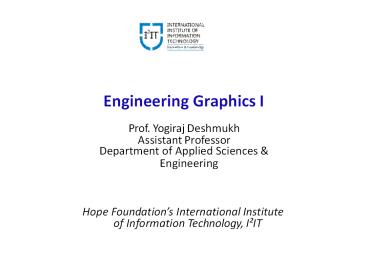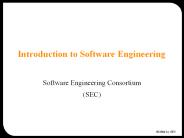Engineering Graphics I - Department of Applied Sciences & Engineering - PowerPoint PPT Presentation
Title:
Engineering Graphics I - Department of Applied Sciences & Engineering
Description:
This presentation covers various topics from Engineering Graphics and is presented by Professor Yogiraj Deshmukh from the department of Applied Sciences and Engineering at International Institute of Information Technology, I²IT. The learning objectives of this presentation are: To study concept of principle planes, To understand theory of projections, Analysis of a point in various quadrants, Analysis of a point in 1st quadrant, Theory of projections by auxiliary plane method: AVP & AIP. – PowerPoint PPT presentation
Number of Views:117
Learn more at:
http://www.isquareit.edu.in/
Title: Engineering Graphics I - Department of Applied Sciences & Engineering
1
Engineering Graphics I
Prof. Yogiraj Deshmukh Assistant
Professor Department of Applied Sciences
Engineering Hope Foundations International
Institute of Information Technology, I²IT
2
Learning objectives
- To study concept of principle planes
- To understand theory of projections
- Analysis of a point in various quadrants
- Analysis of a point in 1st quadrant, different
cases - Summarization of concepts observations
- Theory of projections by auxiliary plane method
AVP AIP
Hope Foundations International Institute of
Information Technology, I²IT P-14, Rajiv Gandhi
Infotech Park, MIDC Phase I, Hinjawadi, Pune
411 057 Tel 91 20 22933441/2/3
www.isquareit.edu.in info_at_isquareit.edu.in 2
3
Concept of Plane
- Plane
- Also known as Plane or Polygon or Lamina or Plate
- Are two dimensional figures i.e. length width,
or width height, or height width. - Every plane is bounded by the true lines hence
it has only one True Shape (TS). - Regular polygons
- Triangle (Equilateral, Isosceles, Right angle)
- Square, Rectangle, Rhombus
- Pentagon, Hexagon, Circle.
Hope Foundations International Institute of
Information Technology, I²IT P-14, Rajiv Gandhi
Infotech Park, MIDC Phase I, Hinjawadi, Pune
411 057 Tel 91 20 22933441/2/3
www.isquareit.edu.in info_at_isquareit.e3du.in
4
Projections of Plane
- If any polygon is parallel to any one reference
plane, then view obtained in that reference
plane is always True Shape of polygon while its
corresponding view is an Edge View, parallel to
XY or in XY, and vice-a-versa. - Inclination made by the plane with HP is (?p)
- Inclination made by the plane with VP is (Fp)
Hope Foundations International Institute of
Information Technology, I²IT P-14, Rajiv Gandhi
Infotech Park, MIDC Phase I, Hinjawadi, Pune
411 057 Tel 91 20 22933441/2/3
www.isquareit.edu.in info_at_isquareit.edu.in 4
5
Types of Problems on Projections of a Plane
- There are two types of problems on projections of
plane - Type A The true shape of plane and data to make
it inclined to HP VP are given, and then draw
the projections to find its inclinations with HP
and VP. - Plane resting in HP on its side or corner
- Plane resting in VP on its side or corner
- Type B The apparent views FV and TV, of a
plane are given, and then draw the projections
to find its inclinations with HP and VP. Also,
find the true shape of a plane.
Hope Foundations International Institute of
Information Technology, I²IT P-14, Rajiv Gandhi
Infotech Park, MIDC Phase I, Hinjawadi, Pune
411 057 Tel 91 20 22933441/2/3
www.isquareit.edu.in info_at_isquareit.edu.in 5
6
Projections of a Plane Type A
- The true shape of plane is given along with the
inclinations made by the plane and line with HP
or VP or special cases. - Draw the projections to make the plane inclined
to both reference planes (oblique plane). - Find the inclinations made by the plane with HP
and VP.
Hope Foundations International Institute of
Information Technology, I²IT P-14, Rajiv Gandhi
Infotech Park, MIDC Phase I, Hinjawadi, Pune
411 057 Tel 91 20 22933441/2/3
www.isquareit.edu.in info_at_isquareit.edu.in 6
7
Type A Stage I
- If plane is resting in HP, then first draw TV as
true shape. - While drawing true shape check that whether it
is resting on its side or corner. - If resting on its side, draw that side extreme
left, perpendicular to XY. - If resting on corner, locate that corner
extreme left with specific cases mentioned if
any. - And vice-a-versa, if plane is resting in VP.
Hope Foundations International Institute of
Information Technology, I²IT P-14, Rajiv Gandhi
Infotech Park, MIDC Phase I, Hinjawadi, Pune
411 057 Tel 91 20 22933441/2/3
www.isquareit.edu.in info_at_isquareit.edu.in 7
8
Type A Stage II
- If plane is resting in HP, then make its surface
inclined to HP first and draw the second TV from
various cases below - Surface is inclined to HP (?p).
- The corner or side opposite to resting side or
corner is above HP. - The side adjacent to resting side or corner
appears as plan or TV length. - --- Continued --
Hope Foundations International Institute of
Information Technology, I²IT P-14, Rajiv Gandhi
Infotech Park, MIDC Phase I, Hinjawadi, Pune
411 057 Tel 91 20 22933441/2/3
www.isquareit.edu.in info_at_isquareit.edu.in 8
9
Type A Stage II
- Some special cases
- The plan or TV of a plane resting on its side
- An Isosceles triangle appears as Equilateral
triangle or Right angle triangle - Rectangle appears as Square
- The plan or TV of a plane resting on its corner
- Square appears as a Rhombus of minor axis,
- Rectangle appears as a Square,
- Circle appears as an ellipse of minor axis etc.
Hope Foundations International Institute of
Information Technology, I²IT P-14, Rajiv Gandhi
Infotech Park, MIDC Phase I, Hinjawadi, Pune
411 057 Tel 91 20 22933441/2/3
www.isquareit.edu.in info_at_isquareit.edu.in 9
10
Type A Stage III
- Draw the final FV and TV by reference plane
method or by auxiliary plane method. - If the resting side of plane is inclined to VP
(FL). - If resting on the corner of polygon, then a line
passing through resting corner is inclined to VP
(FL). Then, this line is TL, its 2nd TV line is
PL inclined to VP i.e. ß. - Find angle made by PL with VP i.e. ß, external
construction. - And vice-a-versa, if plane is resting in VP
Hope Foundations International Institute of
Information Technology, I²IT P-14, Rajiv Gandhi
Infotech Park, MIDC Phase I, Hinjawadi, Pune
411 057 Tel 91 20 22933441/2/3
www.isquareit.edu.in info_at_isquareit.edu.in 10
11
a1
a
c
c1
50
b
b1
45º
b1
a1
70
c a.b
a.b
c
c1
Hope Foundations International Institute of
Information Technology, I²IT P-14, Rajiv Gandhi
Infotech Park, MIDC Phase I, Hinjawadi, Pune
411 057 Tel 91 20 22933441/2/3
www.isquareit.edu.in info_at_isquareit.edu.in 11
12
d1
d
ce
c1
e1
30
a b
b a
d
ce
X
b1
Y
a1
30
0
e1
a
1
e
e1
a1
b1
a
d1
d
c1
d1
b b1 Hope Foundations Interncational Institute
of Information Tce1chnology, I²IT P-14, Rajiv
Gandhi Infotech Park, MIDC Phase I, Hinjawadi,
Pune 411 057 Tel 91 20 22933441/2/3
www.isquareit.edu.in info_at_isquarei1t.2edu.in
13
Type A Stage III
- If resting on the corner of polygon, then a TV
line passing through resting corner is inclined
to VP i.e. ß. - Then, its a line of 2nd TV as PL and it is
inclined to VP at any angle of ß. - No external construction. And vice-a-versa, if pl
ane is resting in VP. - If resting on the corner of polygon, then the
side opposite to resting corner (e.g. all
triangles and pentagon) is inclined to VP (FL). - And vice-a-versa, if plane is resting in VP.
Hope Foundations International Institute of
Information Technology, I²IT P-14, Rajiv Gandhi
Infotech Park, MIDC Phase I, Hinjawadi, Pune
411 057 Tel 91 20 22933441/2/3
www.isquareit.edu.in info_at_isquareit.edu.in 13
14
Type A Stage IV
- By
using auxiliary plane
- method, find the inclinations made by the plane
with HP (?p) and with VP (Fp). - Procedure to find (?p) and (Fp) will be
discussed in problems of Type B - Summarization of various stages of problems in
Type A
Hope Foundations International Institute of
Information Technology, I²IT P-14, Rajiv Gandhi
Infotech Park, MIDC Phase I, Hinjawadi, Pune
411 057 Tel 91 20 22933441/2/3
www.isquareit.edu.in info_at_isquareit.edu.in 14
15
Projections of a Plane Type B
- The apparent views Elevation (FV) and Plan
(TV), of a plane are given with point coordinates
and line dimensions. - Draw the given views FV and TV.
- Draw the projections by using auxiliary plane
method to find its inclinations with HP and VP. - Draw the true shape of a plane by auxiliary plane
method for any one edge view of earlier stage.
Hope Foundations International Institute of
Information Technology, I²IT P-14, Rajiv Gandhi
Infotech Park, MIDC Phase I, Hinjawadi, Pune
411 057 Tel 91 20 22933441/2/3
www.isquareit.edu.in info_at_isquareit.edu.in 15
16
Type B To find ?p
50
- Draw auxiliary FV as an edge view, to find (?p).
- Hence, any one line in the given TV should be
TL. - Check s corresponding line in FV
25
c
15
a
1
- must be parallel to XY.
- If yes, find the point view of that
20
b
10 15
Y x1
X
TL by auxiliary plane method
which will give FV as an edge view of plane.
Extend the TL line, take a line perpendicular
to this TL line as new reference line - X1Y1 ,
draw the projections from all the
a
c
40
1
c1
y2
a1
b
corners of TV polygon to X1Y1
c
1
and locate their distances of
b
1
y1
previous FV from XY.
x2
- If not, then construct a line
parallel to XY inside the plane of
given FV. Project it in the
b1
corresponding line of TV find its TL. Then,
repeat the procedure
d
1
explained as above.
17
Type B To find Fp
- Draw auxiliary TV as an edge view, to find (Fp).
- Hence, any one line in the given FV should be TL.
- Check its corresponding line in TV must be
parallel to XY. - If yes, find the point view of that TL by
auxiliary plane method which will give TV as an
edge view of plane. Extend the TL line, take a
line perpendicular to this TL line as new
reference line - X1Y1 , draw the projections from
all the corners of FV polygon to X1Y1 and locate
their distances of previous TV from XY. - If not, then construct a line parallel to XY
inside the plane of given TV. Project it in the
corresponding line of FV find its TL. Then,
repeat the procedure explained as above. - Y1
- a1b1
Y
2
b
b1
15
a
15
C1
C
10
X1
a
X2
X
Y
1
c
c1
650
300
a
b
50 mm
17
18
Type B To find True Shape
- To find out the TS of a plane, first draw any one
edge view of plane by the procedure explained in
earlier stages. - When we take the auxiliary projections of any one
edge view by drawing the new reference line -
X2Y2, parallel to the edge view, we get the True
Shape of the plane. - For example Draw a new reference line - X2Y2,
parallel to the FV as edge view, Draw the
projections from all the corners of this edge
view to X2Y2 and locate their distances of
previous TV from X1Y1, then we get a new TV as a
True Shape. And vice-a-versa.
Hope Foundations International Institute of
Information Technology, I²IT P-14, Rajiv Gandhi
Infotech Park, MIDC Phase I, Hinjawadi, Pune
411 057 Tel 91 20 22933441/2/3
www.isquareit.edu.in info_at_isquareit.edu.in
19
Thank you
For further information please contact Yogiraj
Deshmukh yogirajd_at_isquareit.edu.in Department
of Applied Sciences Engineering Hope
Foundations International Institute of
Information Technology, I²IT Pune P-14, Rajiv
Gandhi Infotech Park, MIDC Phase I, Hinjawadi,
Pune 411 057 Phone - 91 20 22933441/2/3 www.isq
uareit.edu.in info_at_isquareit.edu.in































